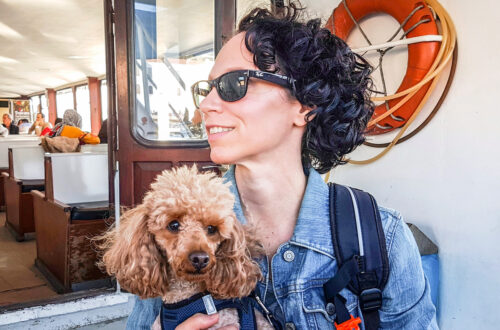
How to Take an International Flight with a Dog in Cabin
Plus What You Need to Know About the EU Pet Passport
As long-term travelers who take our dogs with us everywhere we go, one of the questions we get most frequently is how we manage the international flights.
In fact, before we started our nomadic life with our two toy poodles, we had endless questions. Could we bring them in the cabin with us for a long-haul international flight? What paperwork do we need to take them across borders? Would they be comfortable squished under the seat? Did we need an EU Pet Passport and how could we get it?
Now that we’re pros at taking flights with them, we’ve compiled all the answers that we wished we’d found a year ago! You can read the article or watch the video here.
At this point, we’ve taken our two little poodles on a number of domestic and international flights. The longest and most complicated was a 12-hour flight from Singapore to Poland, when we were permanently leaving our expat home in Singapore with a one-way ticket to Europe. If you’re wondering why we choose Poland, we discovered that the Polish national carrier LOT that both offered the cheapest option for leaving Singapore and also allowed pets in the cabin.

We later flew from Ukraine to Turkey and most recently from Turkey to Italy. We’ve also taken a domestic flight within Turkey, from Istanbul to Dalaman on the southern coast. Of course, traveling domestically by air is a much easier experience as it doesn’t require the same paperwork as crossing borders.
It’s quite a different story when traveling internationally; a lot of documents and careful planning is needed. Let’s start with the country requirements.
Country Requirements
When planning an international trip, the first thing to do is look up the specific requirements for bringing pets into that country. Some of the requirements can take up to 6 months ahead of your travel date so you will want to get started on fulfilling the requirements as soon as possible.
We strongly recommend getting this information from an official government source rather than one of the many websites that aggregate this type of information.
This is important to make sure you have correct and most up-to-date information.
The requirements do vary from country to country so we’ll just touch on the most common requirements you will encounter.
- Before anything else, make sure your dog has been microchipped. This is a critical step for supporting the creation of a paper trail with all the necessary vaccinations and other treatments. As a side note, do be aware that just because your pet has been microchipped, this does not mean that their identification and your contact information has been automatically input into the relevant national or regional databases. If you want to be contacted in the event that your pet is lost and found (as of course you would!), take the time to understand whether or not your dog’s microchip is registered properly with your contact information in the relevant databases, particularly in the countries or regions where you are traveling.
- Your pet will need up-to-date vaccinations, which may be different from those required in your own country
- If you are travelling from a country which has rabies present, you may also need to have a serology test done by an approved lab to prove your pet’s rabies antibodies are above a certain level. For countries in Europe, this needs to be done at least 30 days after your pet has been vaccinated for rabies, and at least three months before your pet travels, so you can see why advance planning is so essential.
- Some countries require specific parasite treatments just prior to departure
- A pet health exam by a vet in the days just prior to traveling, possibly endorsed by an official government vet. During the health exam appointment, your vet will need to fill out a health certificate form for the country you will be travelling to. This is something you can look for online ahead of time or ask your vet office if they already have a copy. Your vet can also direct you to an official government source for final endorsement, if needed by your destination country.
Finally, some countries like Singapore and Australia may impose a quarantine so it may not be realistic to travel to those countries with your pet for a vacation versus a long-term relocation.
Again, all these steps and their specific requirements vary from country to country. It’s very important to get them right as you may be stopped on getting on your departing flight if your paperwork is not in good order. If you aren’t comfortable navigating the requirements on your own, you can always enlist the assistance of a pet travel agent to help.
Airline Requirements
In our experience, it’s actually the airlines that are the most stringent when reviewing your paperwork at the point of flight check in. We’ve had a couple instances when every single page of our dogs’ documentation was photographed by the airlines representative prior to an international flight.
Here are a few items to review closely within the airline’s official pet policy:
- Maximum dimensions of carrier
- Combined weight of carrier and dog
- Requirements related to standing up and turning around within carrier
- Which seat class on which flight allows pets
- Number of pets allowed in cabin
- Cost for bringing a pet in cabin
Note that, similar to country requirements, these can vary quite a bit between airlines. If you plan to take multiple flights, be sure to research each leg of the trip.
Passage for your dog can’t be booked online for most airlines so make sure to call as soon as your plans are made. We recommend booking your ticket and your dog’s ticket at the same time over the phone with an airline representative. That way, you can be certain that there is room for both of you on a flight.
It’s also important to be mindful of the length of flight and the length of any layovers. Dogs are not allowed to roam freely in most airports so typically they would end up stuck in their carrier during the layover. Additionally, not every airport offers a space where dogs can stretch their legs and go to the washroom.
Selecting a Carrier
The right carrier can make all the difference in having a comfortable flight with your dog. Consider the following when selecting a carrier:
- Fit within the airlines dimension and weight requirements
- Fit to your dog’s proportions, whether your dog is tall and leggy like a poodle or short and long like a daschund
- Flexibility for squishing under the seat or even expanding during the flight to provide extra room
- Ventilation
- Rigid bottom with comfortable padding to lay on for long periods
- Comfortable shoulder strap
- Durability
EU Pet Passport
For those of you keen on traveling around Europe with your dog, this bonus content is just for you.
If you will only be visiting one country there is no need to get an EU pet passport. But if your trip is longer than four months or you will be making multiple trips, the EU Pet Passport can save a lot of time and money in the long run.
The EU Pet Passport is a document that allows you to travel into EU countries without needing a new vet certificate each time. It remains valid as long as rabies vaccinations are given by EU veterinarians every year and are documented in the passport. This saves you the extra cost and hassle of making a trip to the vet each time you travel to a new EU country
The way to get it is to simply visit a veterinary office during your first stop in Europe and ask them to fill out the paperwork.
Those are our tips for taking an international flight in Europe with a dog — or two — in the cabin. If you have a few tips of your own, please do leave them in the comments.
If you’re interested in how to have a slow travel lifestyle with your dog, click here to subscribe to our YouTube channel.




8 Comments
Julie
Do you know of anyone who has sent their dog seperately (to Europe) using a cargo carrier that is used to transporting animals in the case of where a dog is too big for the cabin?
Our Freedom Years
Hi Julie,
Great question! In fact, when we originally moved from Canada to Singapore, we had to ship our former dog as cargo since she was too big to come into the cabin. This was a tough decision but it was our only option. I would say that this isn’t a good choice if your dog has strong separation anxiety (as our current dog has). If you’re traveling from North America to Europe, this is a much shorter distance and should be more feasible, especially if you are traveling on the same flight and are there at departure and arrival. Definitely plan for an overnight flight as this is when your dog should normally be sleeping anyway.
Gemma
So much useful information, thanks! Also curious what brand your pet carrier is?
Our Freedom Years
Great to hear you find it helpful! We use the Sturdi carrier and are very happy with it, many flights later. There’s more information in this post: https://ourfreedomyears.com/traveling-the-world-with-a-dog/
Gul Kamisli
We’re about to move from Ireland to Singapore and trying to figure out the rules to secure quarantine-free entrance to the country. We also want to travel with our dog (toy poodle) in the cabin and officers in Nparks told us that it’s possible as long as the pet carrier is sealed/tamper proofed. Do you know anything about sealed/tamper-proofed pet carrier in the cabin?
Our Freedom Years
Congrats on your big move! We’re not familiar with the requirements of bringing a dog into Singapore while in the cabin in a sealed carrier. It might be good to double check the requirements with a pet travel broker, which is what we did when importing our previous dog to Singapore from Canada. Good luck!
Adrian Cate
Hi! I was just wondering what size carrier do you have? We’ve got a mini poodle ourselves. He stands at about 20 inches from his feet to the top of his head.
We are planning to travel from Canada to Switzerland and are worried that if we try to bring into the cabin he will get rejected because he is too tall.
Our Freedom Years
Unfortunately, your dog may indeed be too large for in-cabin travel. Our poodles are actually toy size. Our largest is 13″ from floor to top of head and he is already pushing the limit for in-cabin travel. We use a large-sized Sturdi carrier, which provides the height we need but squishes down to fit under any seat. Good luck with your planning.